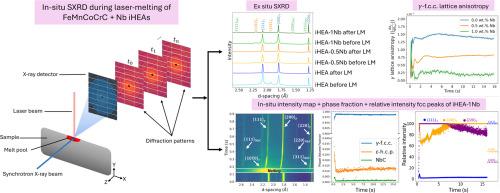Microstructural evolution and phase stability in Nb-containing interstitial Fe-Mn-Co-Cr-C high-entropy alloys: An in-situ synchrotron X-ray diffraction study during laser melting
IF 2.9
Q2 MATERIALS SCIENCE, MULTIDISCIPLINARY
引用次数: 0
Abstract
The influence of Nb on phase stability and microstructural evolution in an interstitial Fe-Mn-Co-Cr-C high-entropy alloy was investigated using in-situ synchrotron X-ray diffraction (SXRD) during laser melting. Scheil-Gulliver simulations predict the formation of σ and γ-f.c.c. phases in all three alloys, along with NbC in Nb-containing compositions. SXRD confirmed the presence of most predicted phases, but the σ phase was absent. Nb promotes crystallite refinement and increases dislocation density, though excessive additions reduce refinement efficiency due to solubility limits and secondary phase formation. Furthermore, Nb addition also enhances ε-h.c.p. phase formation by reducing stacking fault energy through NbC-induced carbon depletion. Analysis of intensity peak evolution reveals that Nb alters preferred grain orientations, reducing intensity while enhancing , leading to a more isotropic grain distribution. Overall, Nb plays a key role in phase selection, microstructure refinement, and preferred orientation evolution, allowing the tailored microstructure of high-entropy alloys via rapid solidification.

含nb间隙Fe-Mn-Co-Cr-C高熵合金的显微组织演变和相稳定性:激光熔化过程的原位同步x射线衍射研究
采用原位同步x射线衍射(SXRD)研究了Nb对Fe-Mn-Co-Cr-C间隙高熵合金激光熔化过程中相稳定性和显微组织演变的影响。Scheil-Gulliver模拟预测了σ和γ-氟化碳的形成。三种合金中的相,以及含铌成分中的NbC。SXRD证实了大部分预测相的存在,但σ相不存在。Nb促进了晶体的细化,增加了位错密度,但由于溶解度的限制和二次相的形成,过量的添加会降低细化效率。此外,Nb的加入也增强了ε-h.c.p。通过nbc诱导的碳耗尽降低层错能形成相。强度峰演化分析表明,Nb改变了晶粒择优取向,降低了{111}γ强度,增强了{220}γ,使晶粒分布更加各向同性。总体而言,Nb在相选择、微观组织细化和择优取向演变中起着关键作用,使高熵合金能够通过快速凝固形成定制的微观组织。
本文章由计算机程序翻译,如有差异,请以英文原文为准。
求助全文
约1分钟内获得全文
求助全文
来源期刊

Materialia
MATERIALS SCIENCE, MULTIDISCIPLINARY-
CiteScore
6.40
自引率
2.90%
发文量
345
审稿时长
36 days
期刊介绍:
Materialia is a multidisciplinary journal of materials science and engineering that publishes original peer-reviewed research articles. Articles in Materialia advance the understanding of the relationship between processing, structure, property, and function of materials.
Materialia publishes full-length research articles, review articles, and letters (short communications). In addition to receiving direct submissions, Materialia also accepts transfers from Acta Materialia, Inc. partner journals. Materialia offers authors the choice to publish on an open access model (with author fee), or on a subscription model (with no author fee).
 求助内容:
求助内容: 应助结果提醒方式:
应助结果提醒方式:


